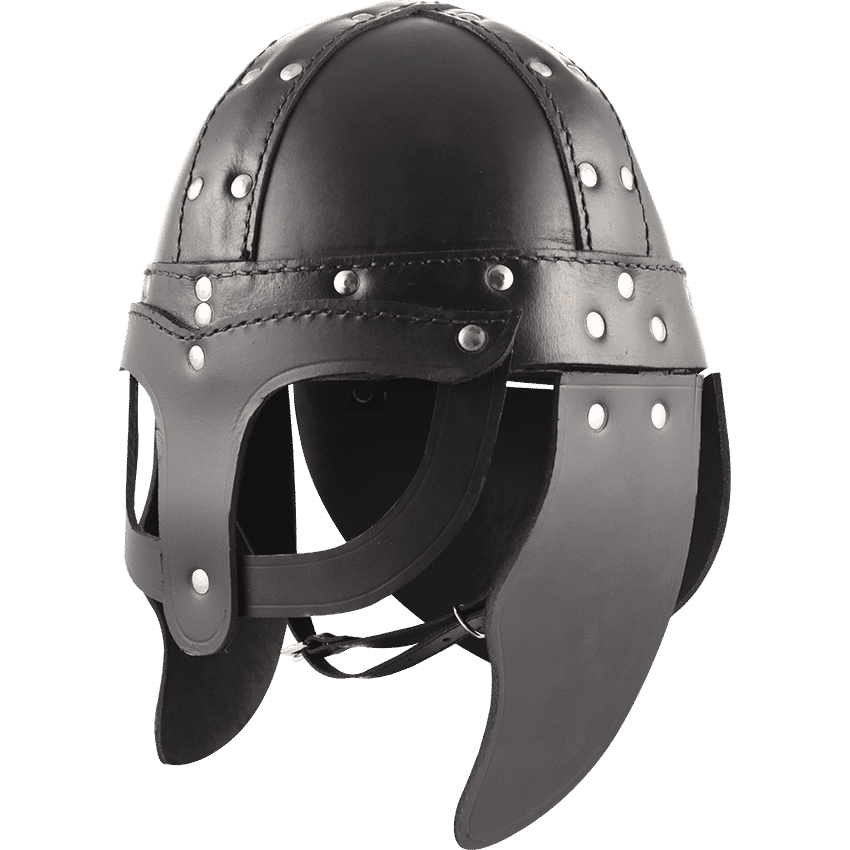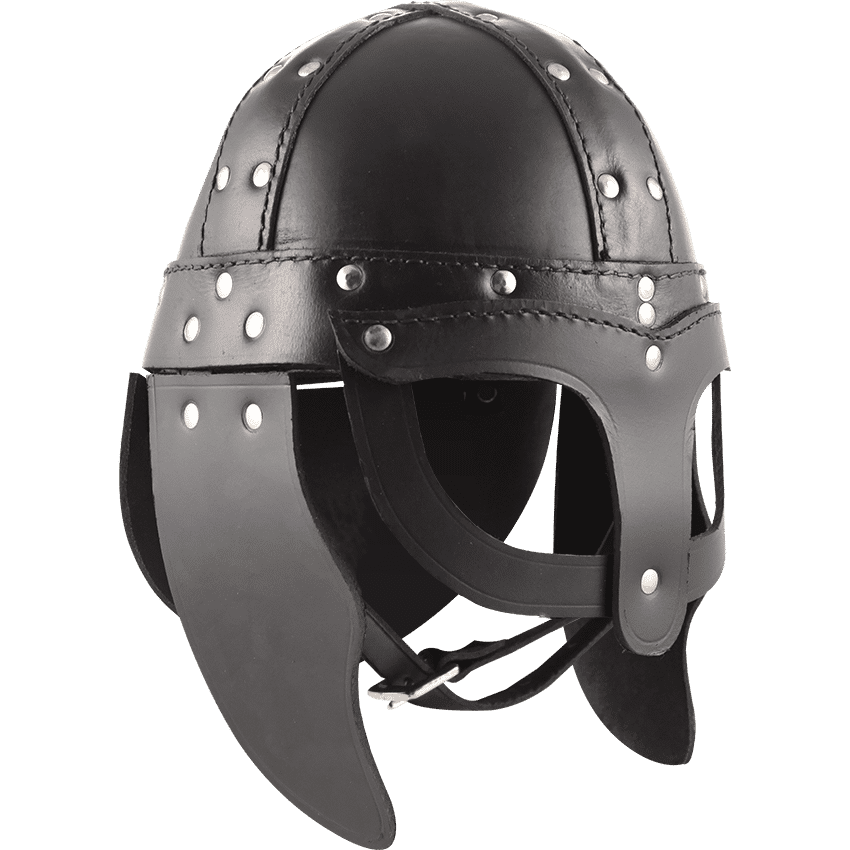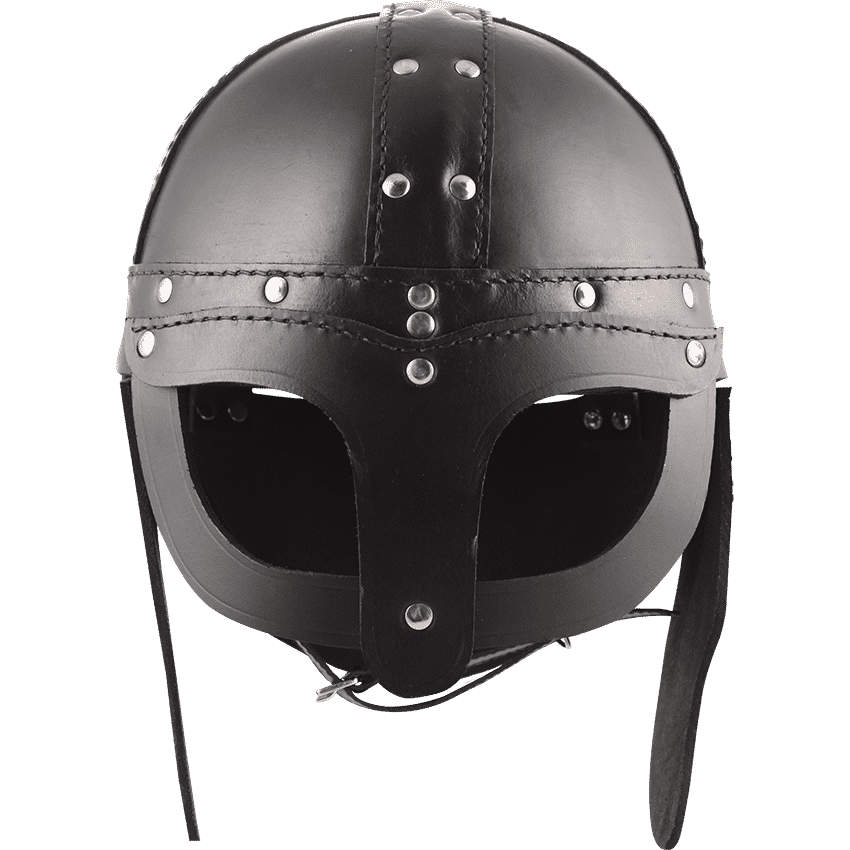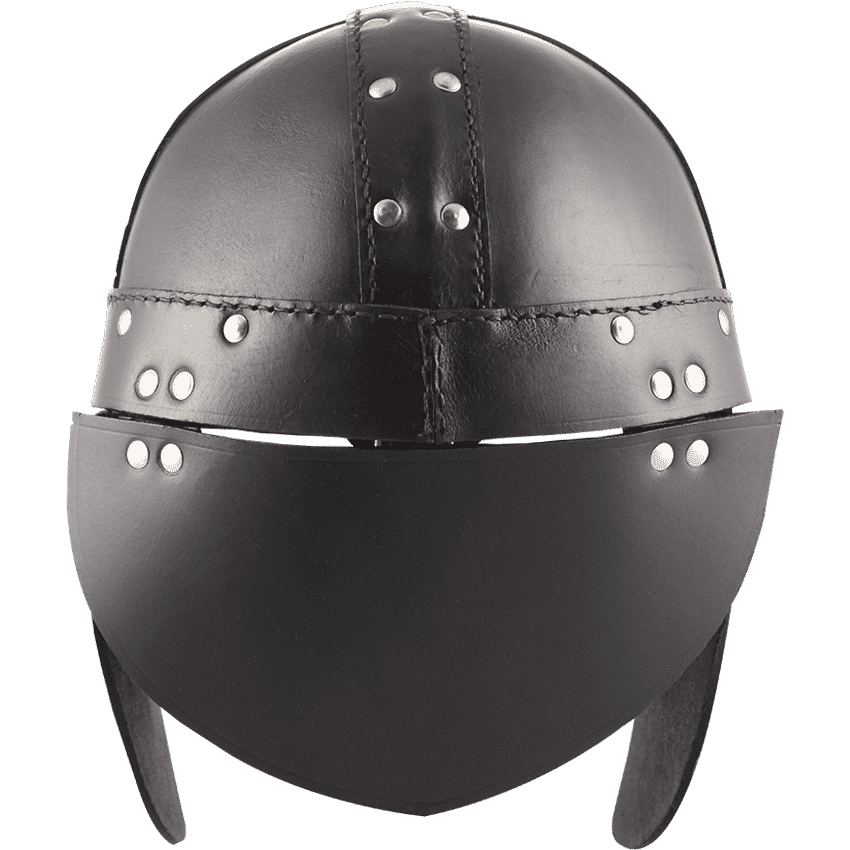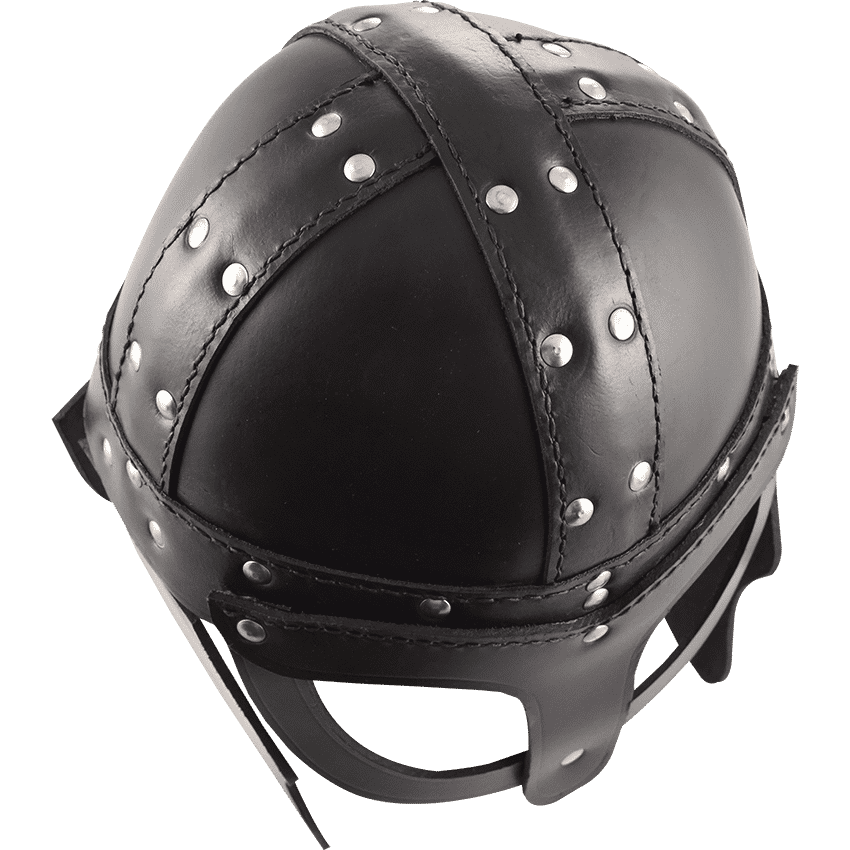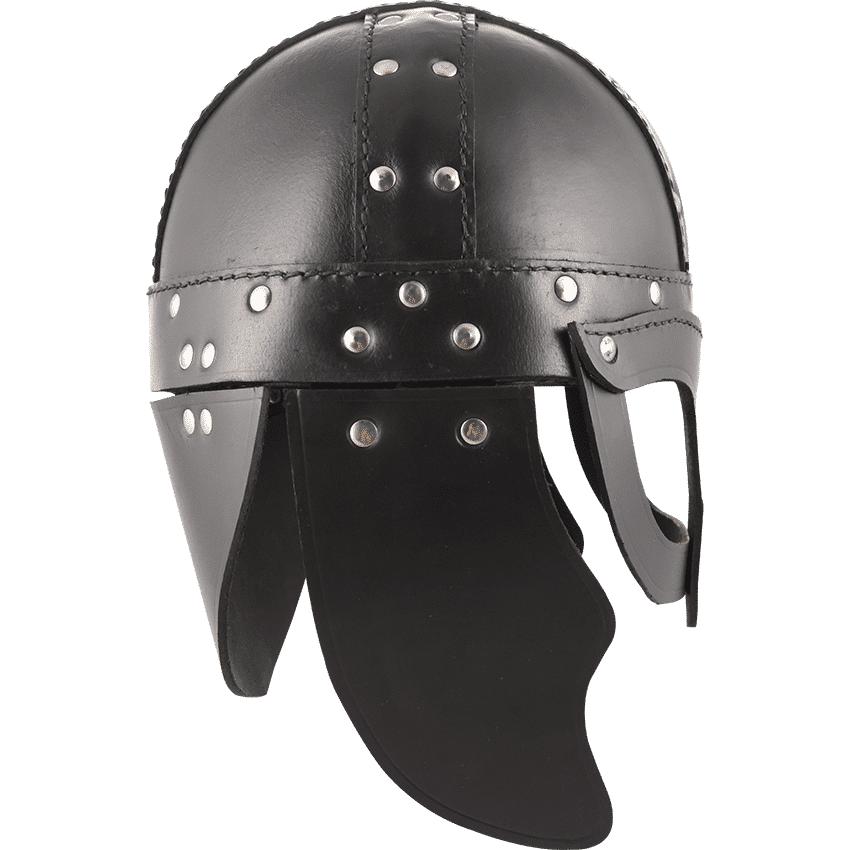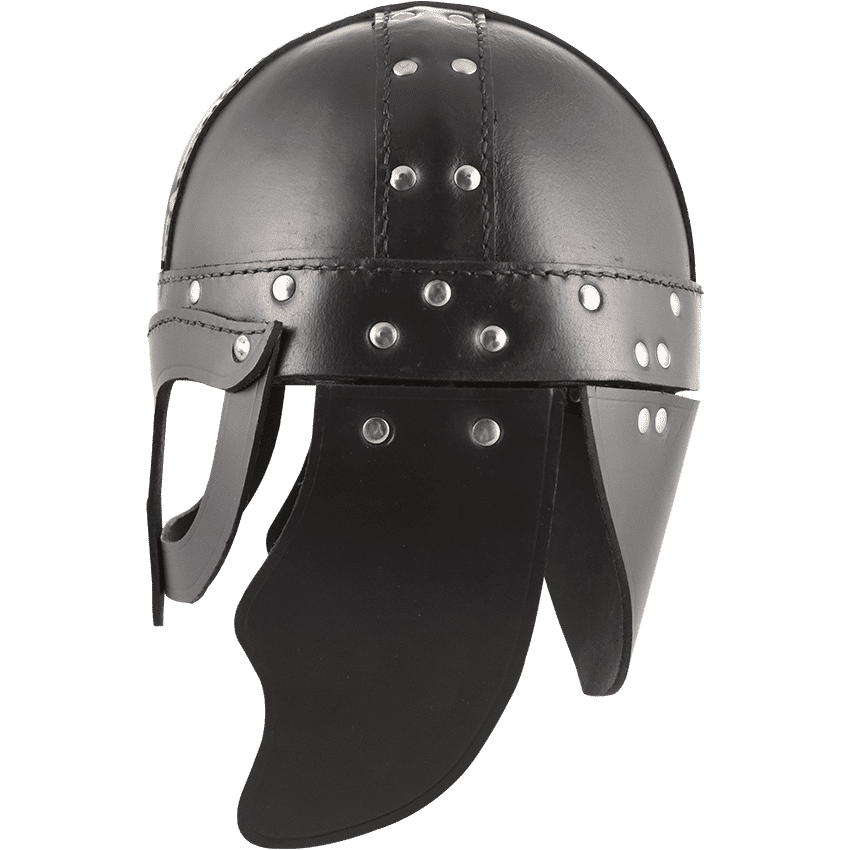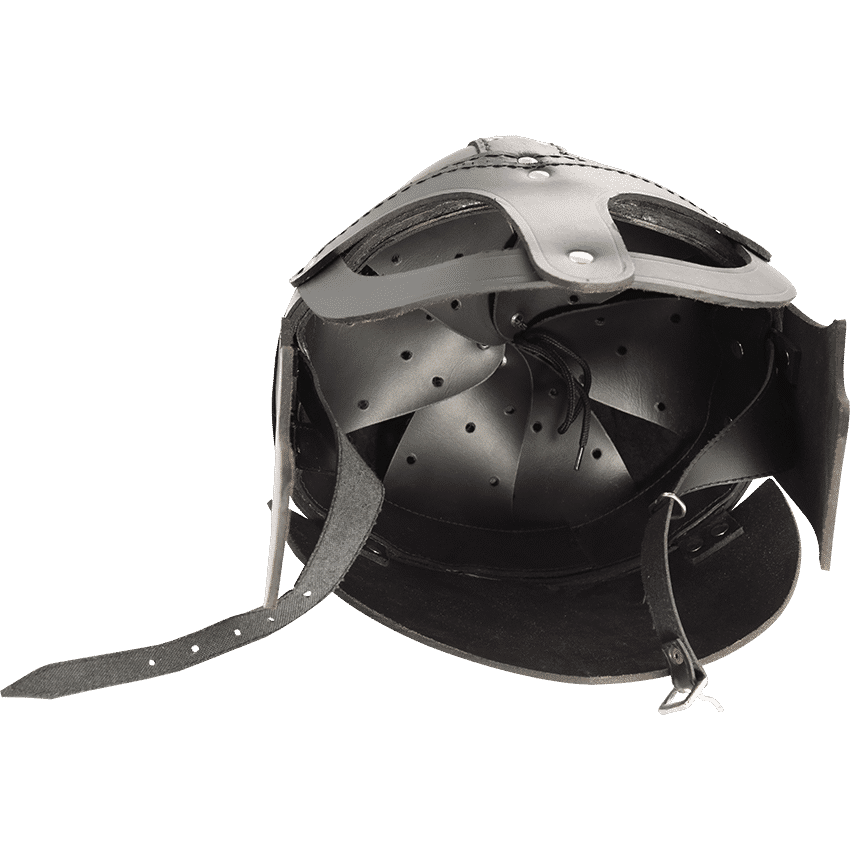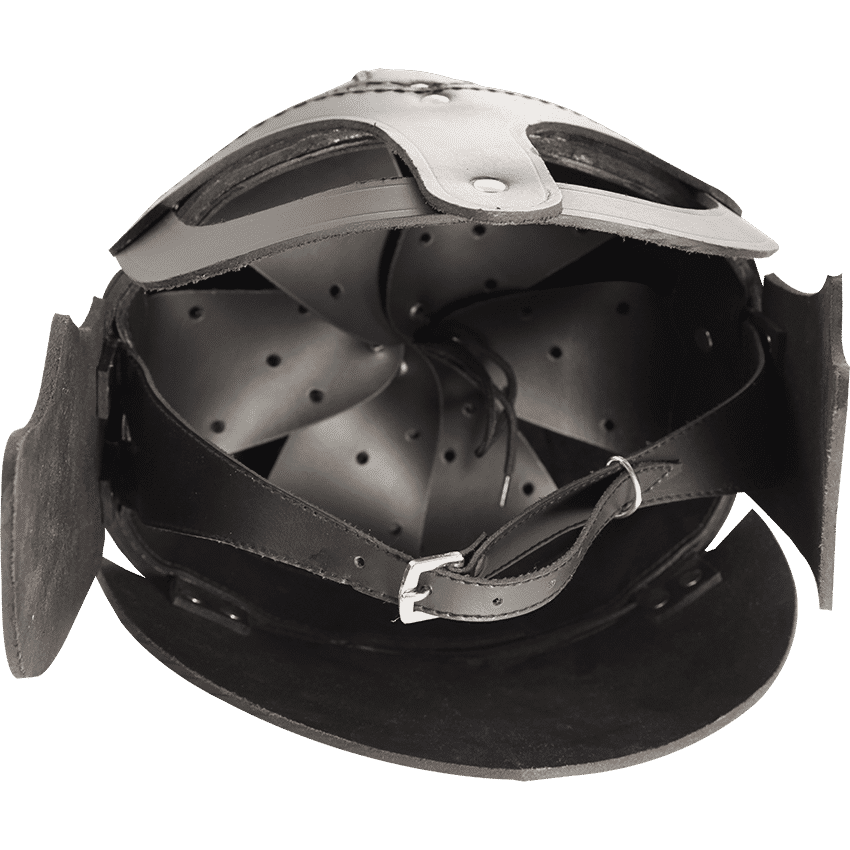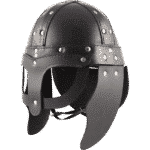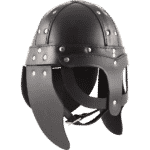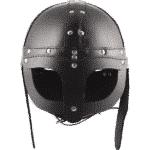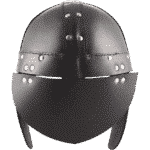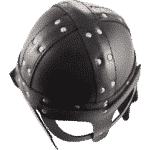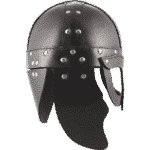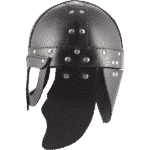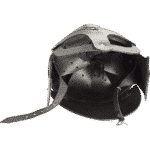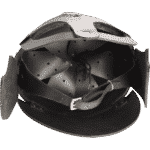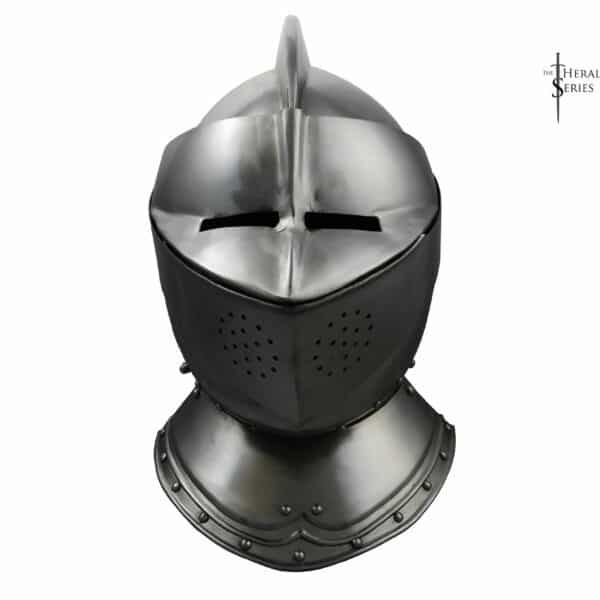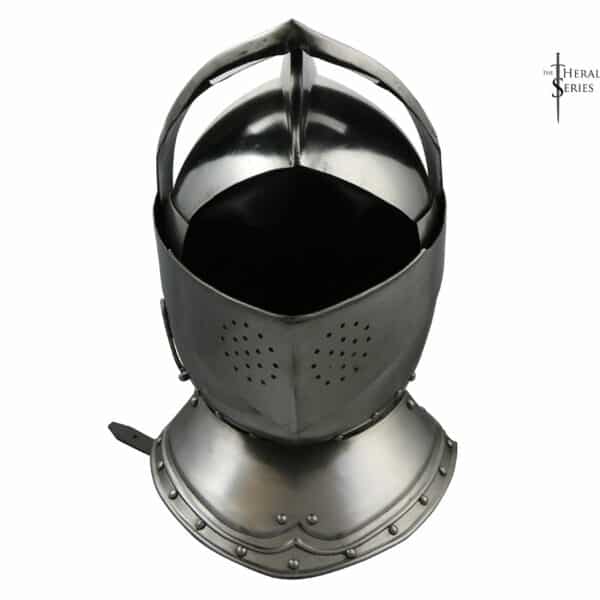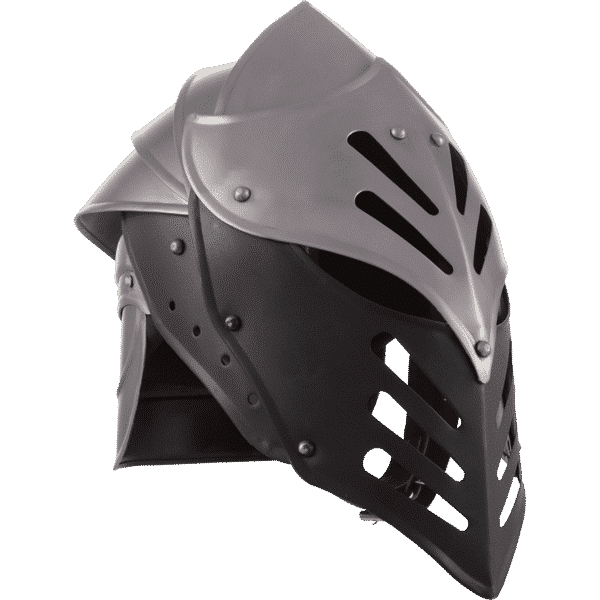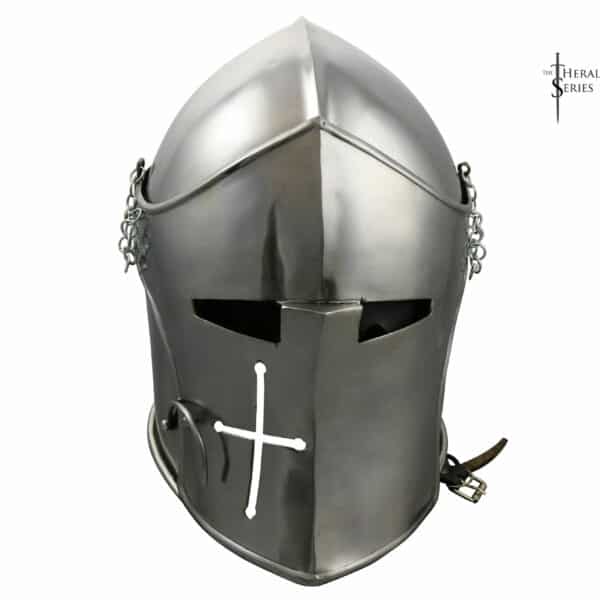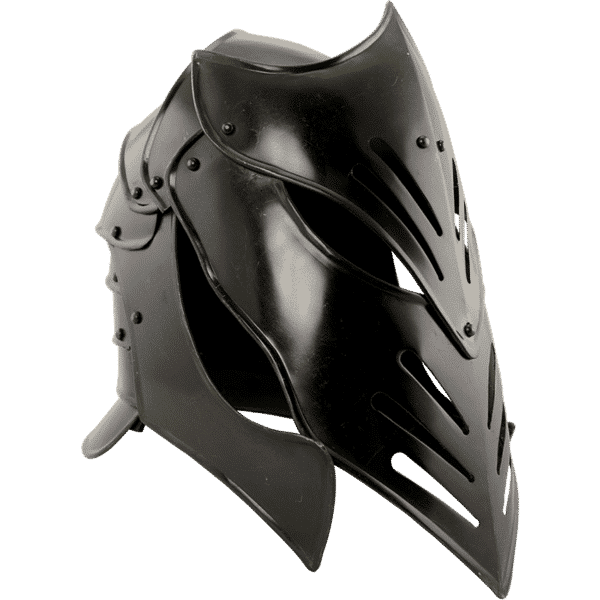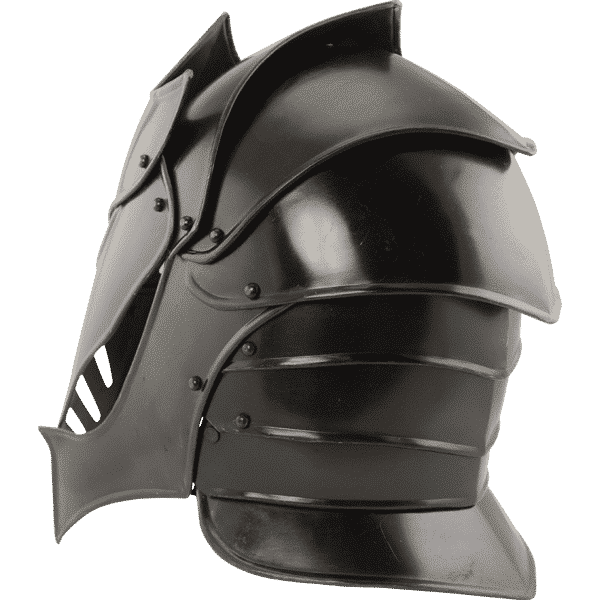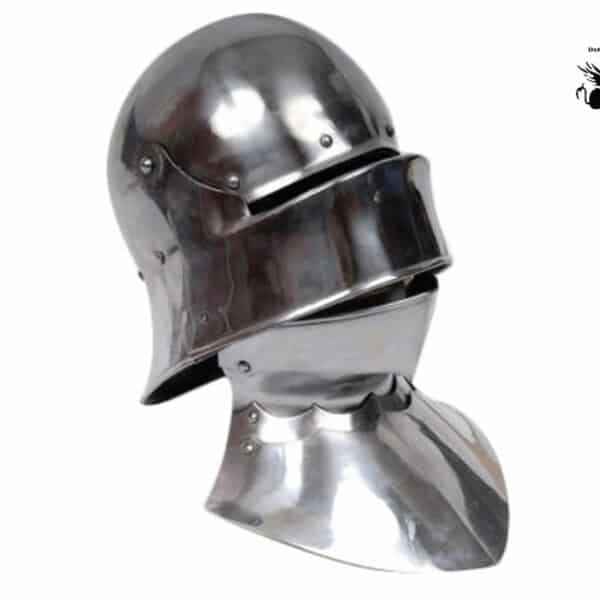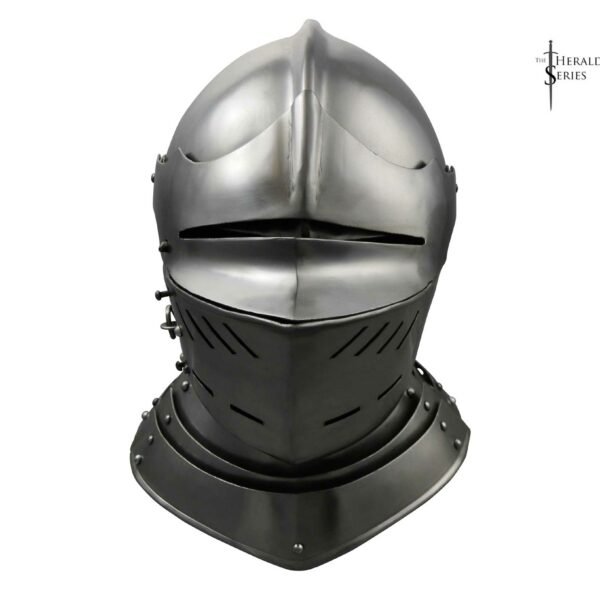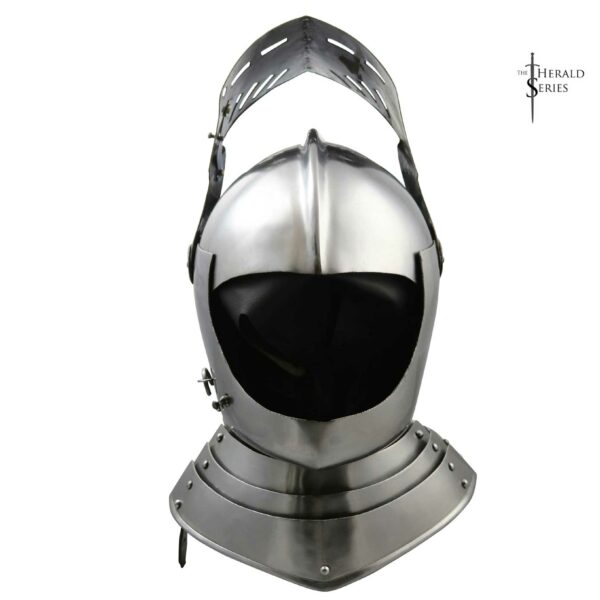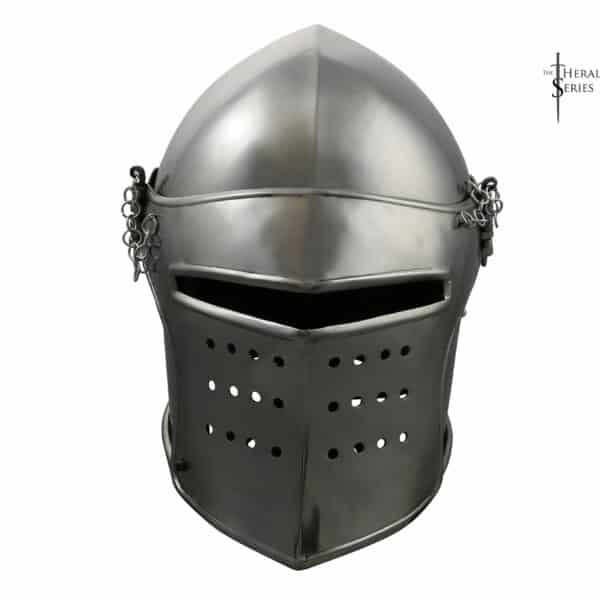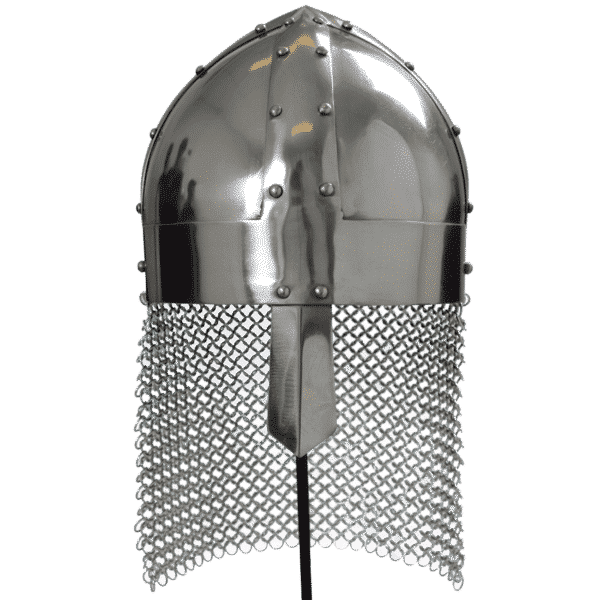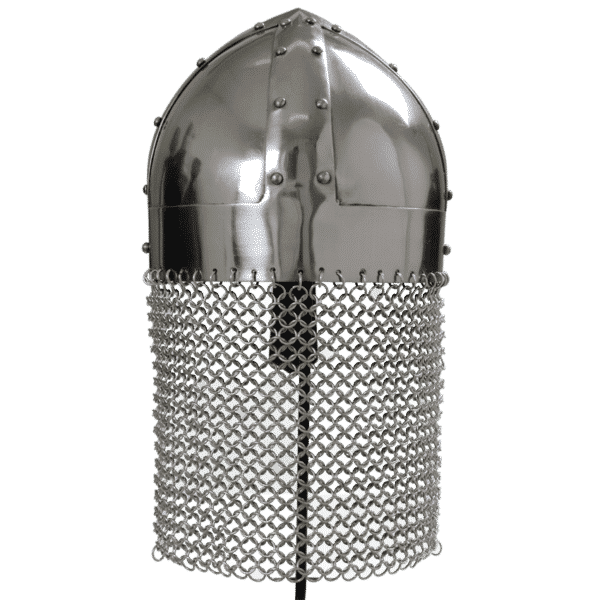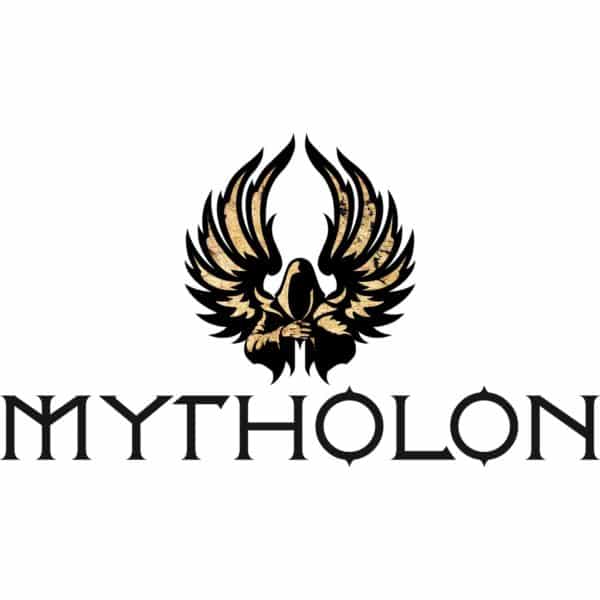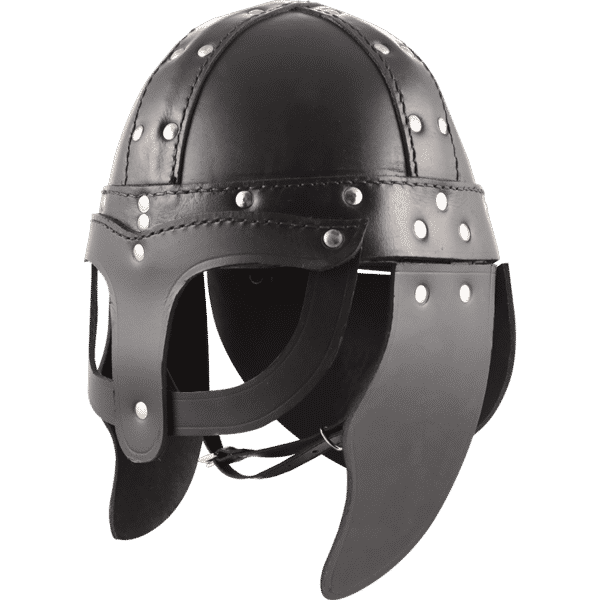Leather Viking Helmet
(About): A Lost Viking Helmet, Remade in Black Leather
Fierce Viking warriors leaping off their boats into the shallows and stealing closer to the sleeping monastery, their black, unpolished iron helmets not catching the lights of the sentries’ torches until it is too late… This is the proud heritage of lightning raiding that you lay claim to with out Leather Viking Helmet. Built to closely imitate real historical Viking helmets like the glorious finds at Gjermundbu, our Leather Viking Helmet is a lightweight and affordable substitute for a metal helmet: perfect for roleplayers seeking more comfortable head projection for a long day’s LARP, or for those wanting to depict a dark leather-clad warrior.
Careful Historical Reproduction
Our Leather Viking Helmet is based on the early-medieval spangenhelm, an enormously popular style of helmet amongst Vikings (and European warriors generally). This type of helmet was made from several small plates of hammered metal – originally bronze, but by the Early Middle Ages iron was the go-to metal. Smiths would usually make four or six of these small plates, and then would rivet them together with a metal framework made from strips or ribs, known as spangen; ‘braces’ in Old German. Spangenhelms were one of several early-medieval helmet styles that had come to Northern Europe from far afield during Late Antiquity: mounted warriors from several Middle Eastern and Eurasian Steppe people brought the spangenhelm type to Western Europe when they were called up to serve in the Roman Empire’s doomed attempts to contain the increasing porosity of its borders. Western European client peoples on the borders of the Empire recognised this style as a highly effective one: cheap to reproduce, and not requiring any great skill, they could be made with poor-quality local ‘bog iron’ that precipitated in many marshes and wetlands. It was these peoples, chief amongst whom were the peoples who lived along the Saxon shore, who would gradually spread into Scandinavia and become the Viking peoples by around the 8th-century CE. In our Leather Viking Helmet, the spangenhelm is represented by the reinforced leather strips which run across the dome of the helmet from brow to nape, and from ear to ear, and the reinforcement around the brim. We also have a stunning steel Viking helmet for sale, for those seeking something a little more heavy metal!
This form of spangenhelm is what is known as a ‘spectacle helmet’. At the front of the brim, a projecting nose-guard is met with guards which protect the eyes to form two eye-holes that resemble a pair of eyeglasses. This style is visible in several Vendel-era and Viking helmets, such as the stunning helmet found at Gjermundbu – it would have provided greater protection than a simple nasal helmet, and also gives its wearer a fearsome inhuman aspect. Our Leather Viking Helmet also has handsome cheekpieces: these descend directly from the Roman styles of helmet such as the galea, and their continued use into the Viking Age demonstrates the depth with which they remained associated with status and martial prowess. The rear of the helmet has an imitation aventail, mimicking the mail neck defense that many Viking helmets were outfitted with.
Modern Wearability for Roleplay and Re-Enactment
The utmost care has been gone to in making sure that our Leather Viking Helmet is a robust piece of roleplay and re-enactment armor that’ll stand up to the rigors of the field. It is made from handsome black leather that is thick and sturdy – all it’ll need is a bit of black polish and the occasional dob of leather conditioner to keep it in tip-top condition year after year. All of the leather pieces are attached with secure locked stitching, and the hand-riveting is not just eye-catching but also contributes to the structural integrity of the helmet. The interior of the helmet is fitted with a modern suspension system. In the Early Middle Ages, a Viking shieldmaiden might have stuffed her helmet with straw, moss or rags to cushion her head from blows, but our Leather Viking Helmet’s suspension system makes such (soggy) tasks unnecessary: with a quick adjustment to your head size, it sits perfectly and comfortably to take the knocks of light combat, re-enactment and roleplay.
Although there is little evidence that the Norse peoples ever used leather as a practical armor, our Leather Viking Helmet does a fantastic job of reproducing authentic Viking shapes and styles for your battlefield. It’s far lighter (and frankly much more comfortable to wear for prolonged periods!) than a metal Viking helmet – it would make a perfect match with any of our black leather Viking torso armor. Don our black Leather Viking Helmet and let your dark berserker soul howl!
(History): The Gjermundbu Helmet
Norway was under Nazi occupation in 1943. The Reich had violated Norwegian neutrality in 1940, launching a blitzkrieg invasion that devastated Norway’s armed forces; King Haakon VII and the civilian government had fled, and the leader of the fascist National Gathering party – the infamous Vidkun Quisling, whose name has become eponymous with traitors – had formed a collaborator government. Amongst the food shortages, garrisoned German troops and resistance raids, ordinary Norwegians had to live on. It is amazing to think that one of the most important finds of Viking armor was made during this dark era.
The Grave of an Ancient Warrior
In March of that year, archaeologists from the Universitetets Oldsaksamling (the University of Oslo’s antiquities collection) spoke to a farmer called Lars Gjermundbo – the farmer had found a dug into a large mound on his land at his farm at Gjermundbu in southern Norway. The museum conservator Sverre Marstrander and his assistant Charlotte Blindheim jumped at the chance to examine the site the following month – and their wildest hopes were soon confirmed. The mound was a classic burial mound: made from stony soil six feet tall and almost thirty yards long, it had a grand status that was rich with promise. Inside the mound they found a stone pavement – a great sign – and then, after painstaking work, two graves.
These graves contained a wealth of personal treasure. They included items related to a whole host of pursuits – horsemanship, archery, even game pieces and cooking utensils. The artistic style and construction of these objects permitted Mastrander and Blindheim to date the burials to the late 10th-century CE: this was the High Viking Age, when Norway was a flourishing and outward-looking kingdom, with an established colony on Iceland, a new settlement being founded in Greenland – and an intrepid Leif Eriksson landing on the shores of Vinland, ‘the land of wild grapes’, modern Newfoundland, Canada. Archaeologists at the time interpreted this as the equipment of a male warrior, but the Viking Age continues to throw mysteries at us: genetic analysis has shown that a large proportion of what were assumed to be male warrior burials contain the bodies of women, so there is a possibility that Gjermundbu contained the grave of a warrior woman since it contained both domestic and war-related grave goods. But most fascinating of all, the Gjermundbu burial contained a fantastic suit of chainmail and a gorgeous fragmented helmet.
The Majestic Helmet Up Close
The Gjermundbu helmet is an amazing characteristic helmet from the period; our Viking Leather Helmet has been based closely upon it. It is also a spangenhelm construction, made from four quarter-dome plates, which have been united together by a framework of spangen and riveted in place. There was a short spike about an inch long at the peak of its dome – whether this was an added weapon to give a nasty bite to a headbutt, or whether it was an aesthetic addition is a matter of some debate; the simple manner of its attachment seems to suggest that it was aesthetic. The helmet had a distinctive ‘spectacle’ eye-guard, like our Leather Viking Helmet. Unlike our Leather Viking Helmet, it seems likely that it did not have articulated cheek guards – but it seems likely that the Gjermundbu helmet did have an aventail at the rear of the helmet: a curtain of mail hanging down to the shoulders designed to protect the back of the neck.
The Real Archaeology
Many articles and write-ups from breathless amateur historians will describe these items as ‘complete’ or ‘the only known’ so-and-so – depicting an image of Charlotte Blindheim brushing aside some soil to find a whole Viking helmet staring up at her from its empty spectacles. The reality is less glamorous but no less fascinating – archaeologists and conservators have spent countless hours documenting, reconstructing and contextualising the Gjermundbu treasures. The armor was discovered jumbled together and decaying, with the helmet broken into 17 fragments. This is what Blindheim and Mastrander’s find tray would have looked like after the parts had been cleaned. Around one-quarter to one-third of the helmet has survived, which is absolutely astonishing considering that it has been buried almost a whole millennium before. Often, helmets have to be theorised and reconstructed from far less. Other contemporary spectacle helmets have had to have been extrapolated from far less. For example, the stunning Tjele helmet was theorised from only a small bronze scrap consisting of the finely-decorated brow of the spectacle piece which was originally interpreted as a saddle mounting!
The Secrets of Gjermundbu
The reconstruction – or more specifically, the rearrangement of the fragments – of the Gjermundbu helmet as it appears in modern pictures was the result of an enormous amount of painstaking work – but it has revealed some fascinating details about the helmets of the era. The spangenhelm construction of the Gjermundbu helmet was not merely a simple strap-and-plate arrangement. Rather, the quarter-dome plates were held in place by two spangen, one on the outside of the helmet and another on the inside, the rivets passing through only the spangen with the plates sandwiched into place. This would have meant the plates could move very slightly independently of the riveted spangen structure, giving the helmet a little ‘spring’ when impacted – functionally, it would have been able to absorb more energy without splitting, and was likely a direct response of a skilled smith to the limitations of multi-part spangenhelm construction. The thickness of the iron is around 1mm in the plates, and a little thicker (1.2-1.5mm) for the spangen structure – this would have meant that the helmet was not enormously heavy, and we know from saga sources that Viking warriors would have worn their helmets all day in times of battle; hence it had to be a thoroughly comfortable and wearable object. The aventail remains a little bit of an enigma: where many aventails on other historical medieval helmets are secured to a leather band sewn onto the helmet, or by small pierced rivets called vervelles, the Gjermundbu helmet has pierced holes, a couple of which even have surviving rings in place. But these are very thick and are only butted together rather than being riveted. Whether these were the mountings for a riveted chainmail, perhaps attached on a wire running through the butted rings, remains a mystery.
Overall, the Gjermundbu helmet still remains enigmatic, despite giving up so many of its secrets. Who was the warrior who wore it? Were they a king, a shieldmaiden or a berserker? What purpose did it serve – ceremonial or military? These are the kinds of questions that you can answer with our Leather Viking Helmet: now, it is up to you to write your own history!
Technical Specifications:
- Material: Leather
- Secondary materials: Metal rivets
- Color: Black
- Weight: 4.4 oz.
- Size:
Interior Circumference: 25.25 Inches

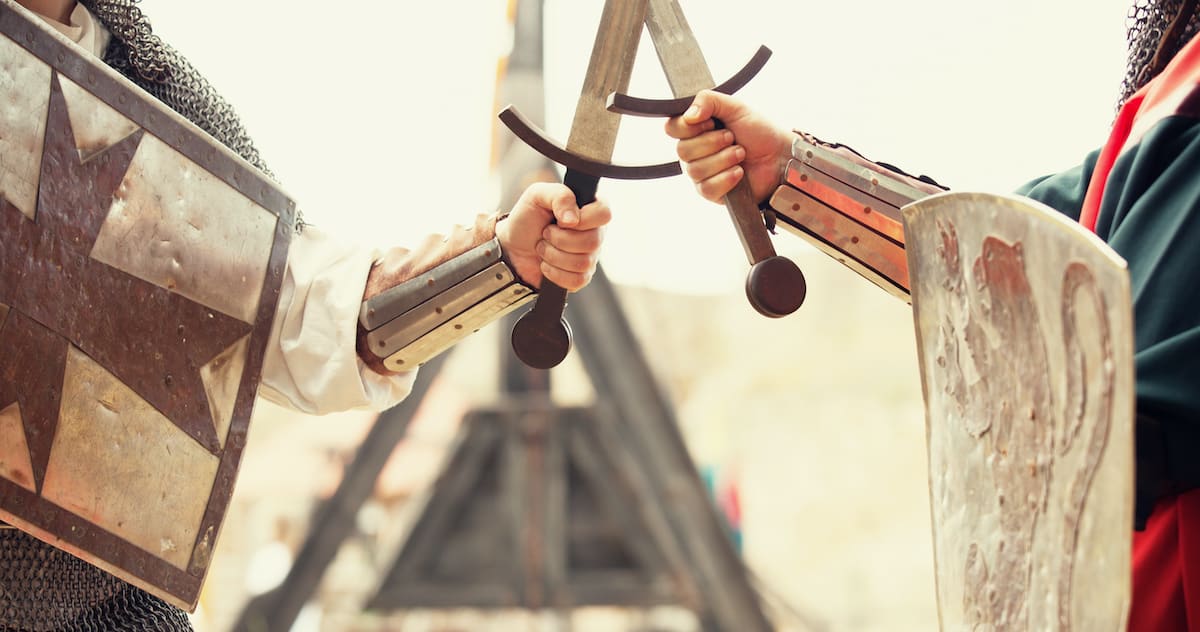 Historical Swords
Historical Swords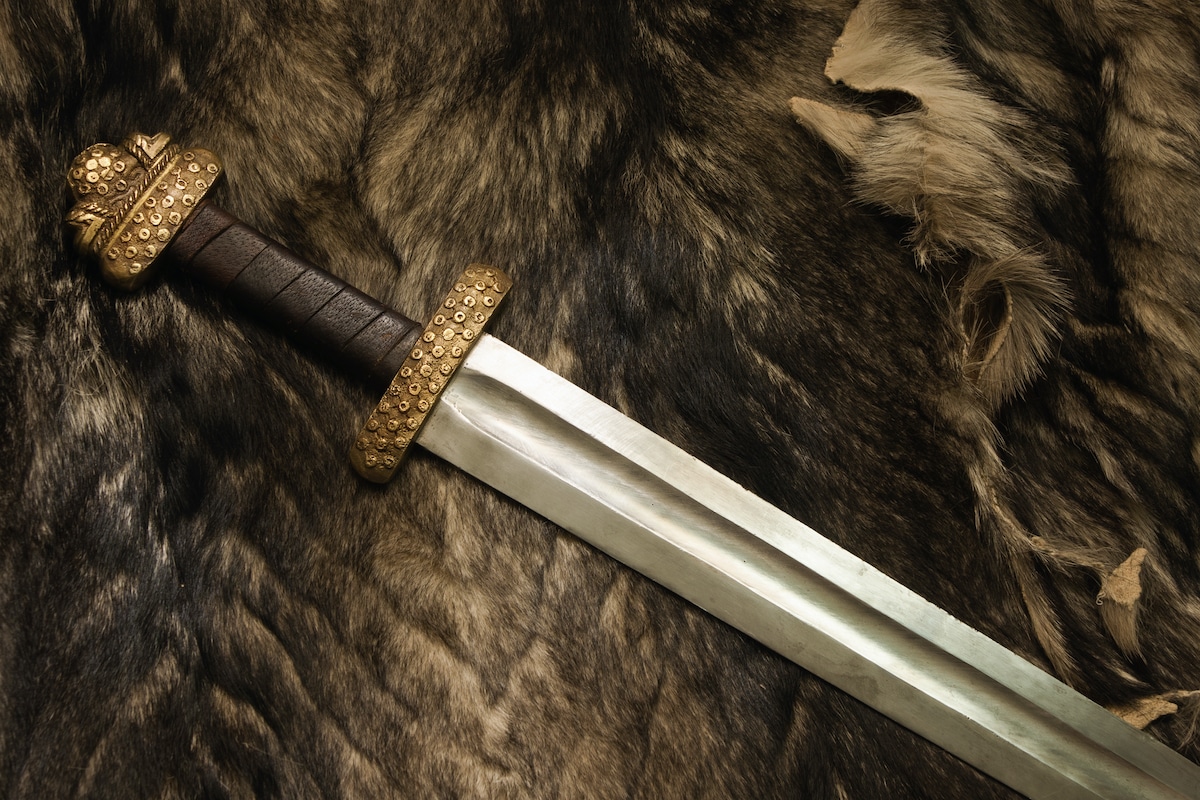 Norse & Viking Swords
Norse & Viking Swords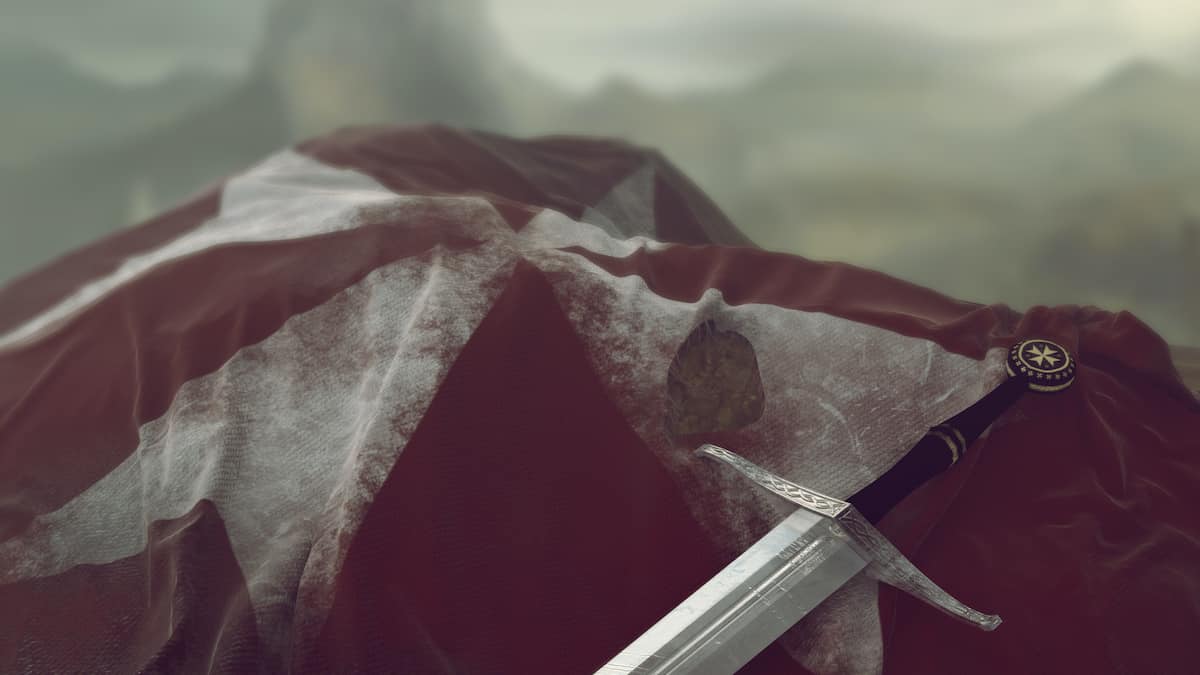 Templar Swords
Templar Swords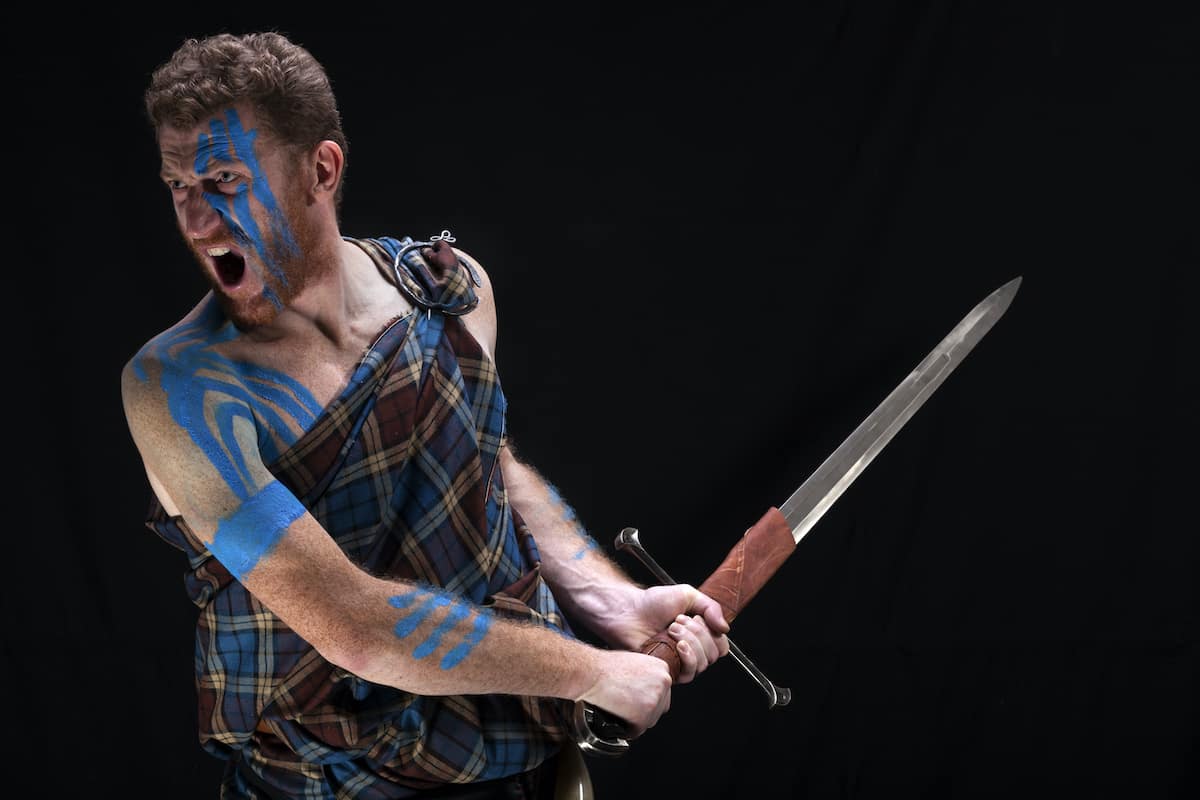 Claymore Swords
Claymore Swords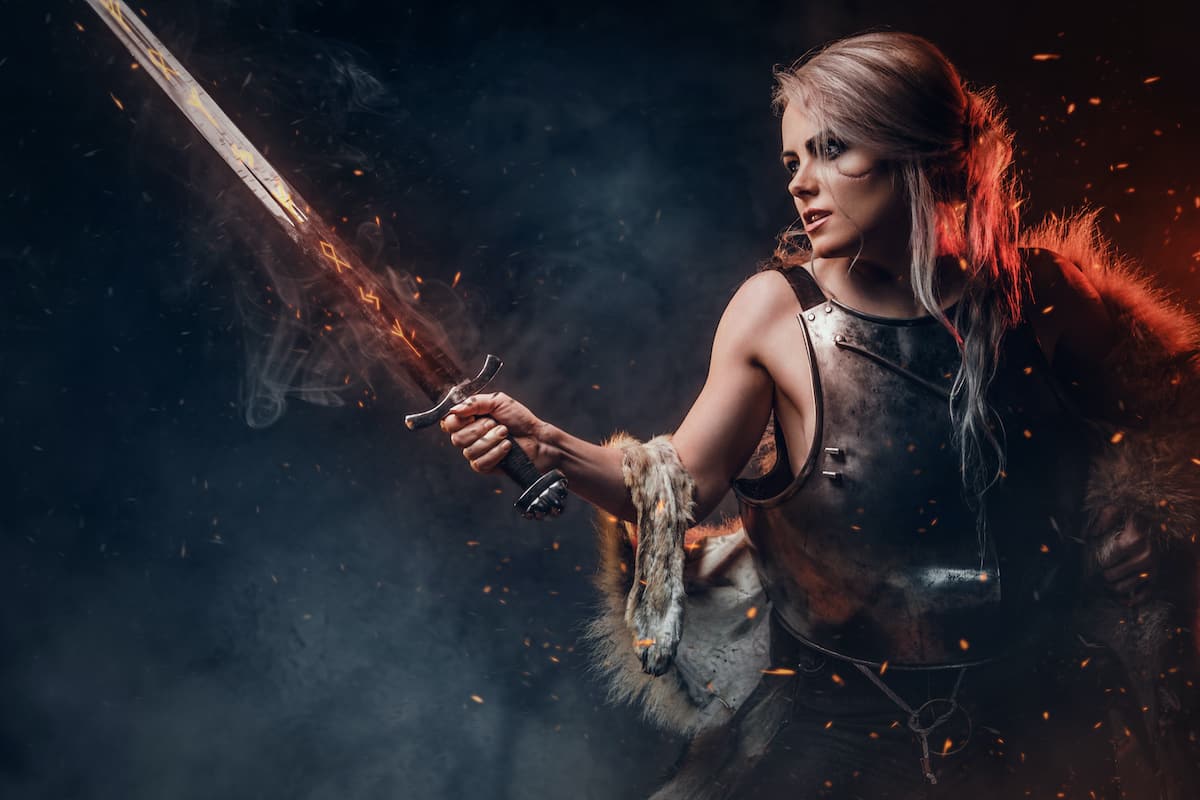 Fantasy Swords
Fantasy Swords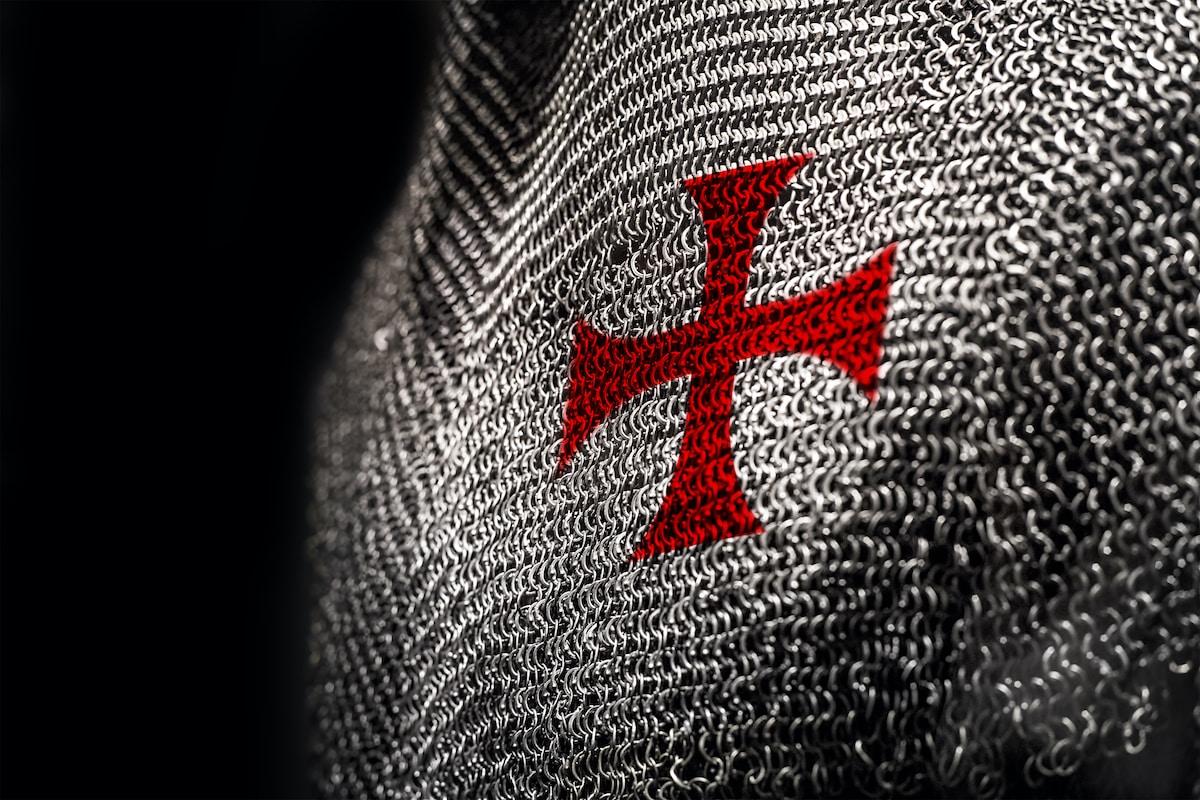 Chainmail
Chainmail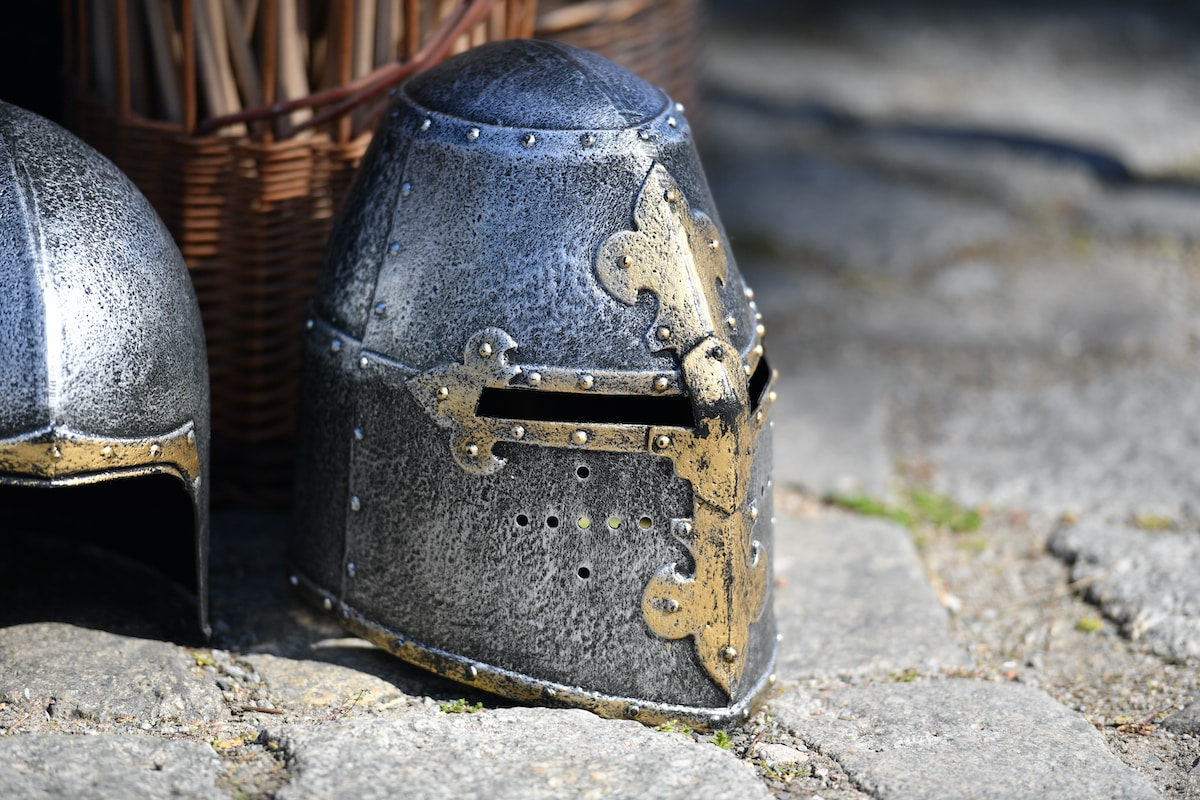 Helmets
Helmets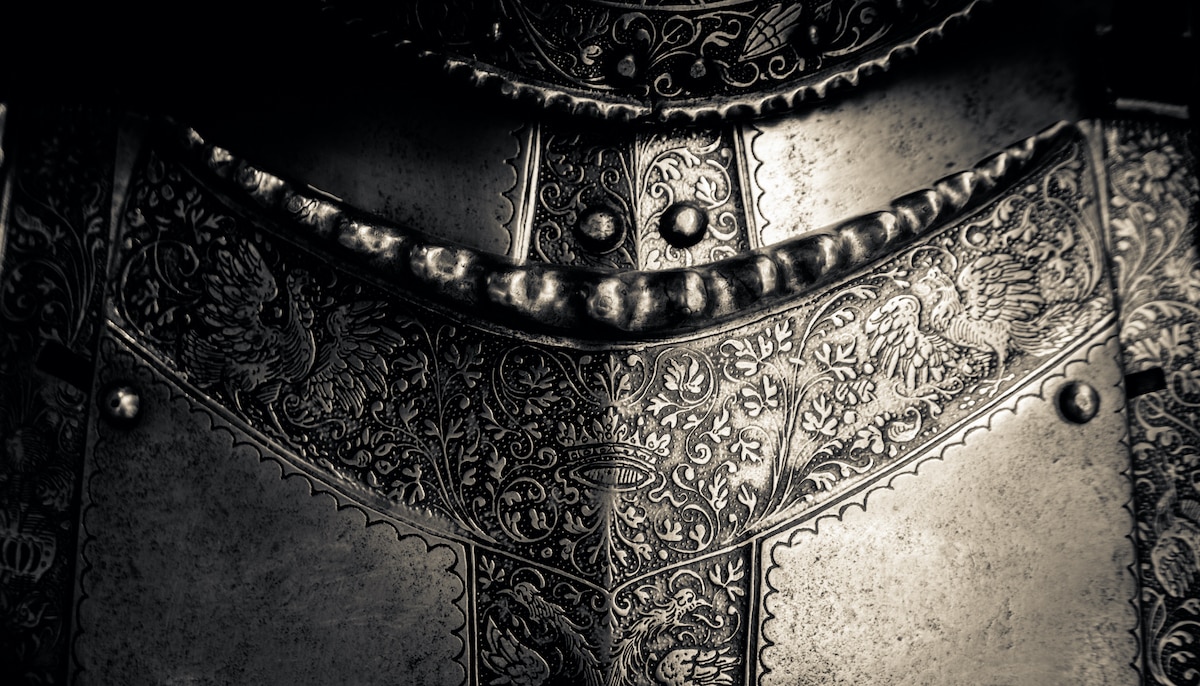 Torso Armor
Torso Armor Bracers and Arm Protection
Bracers and Arm Protection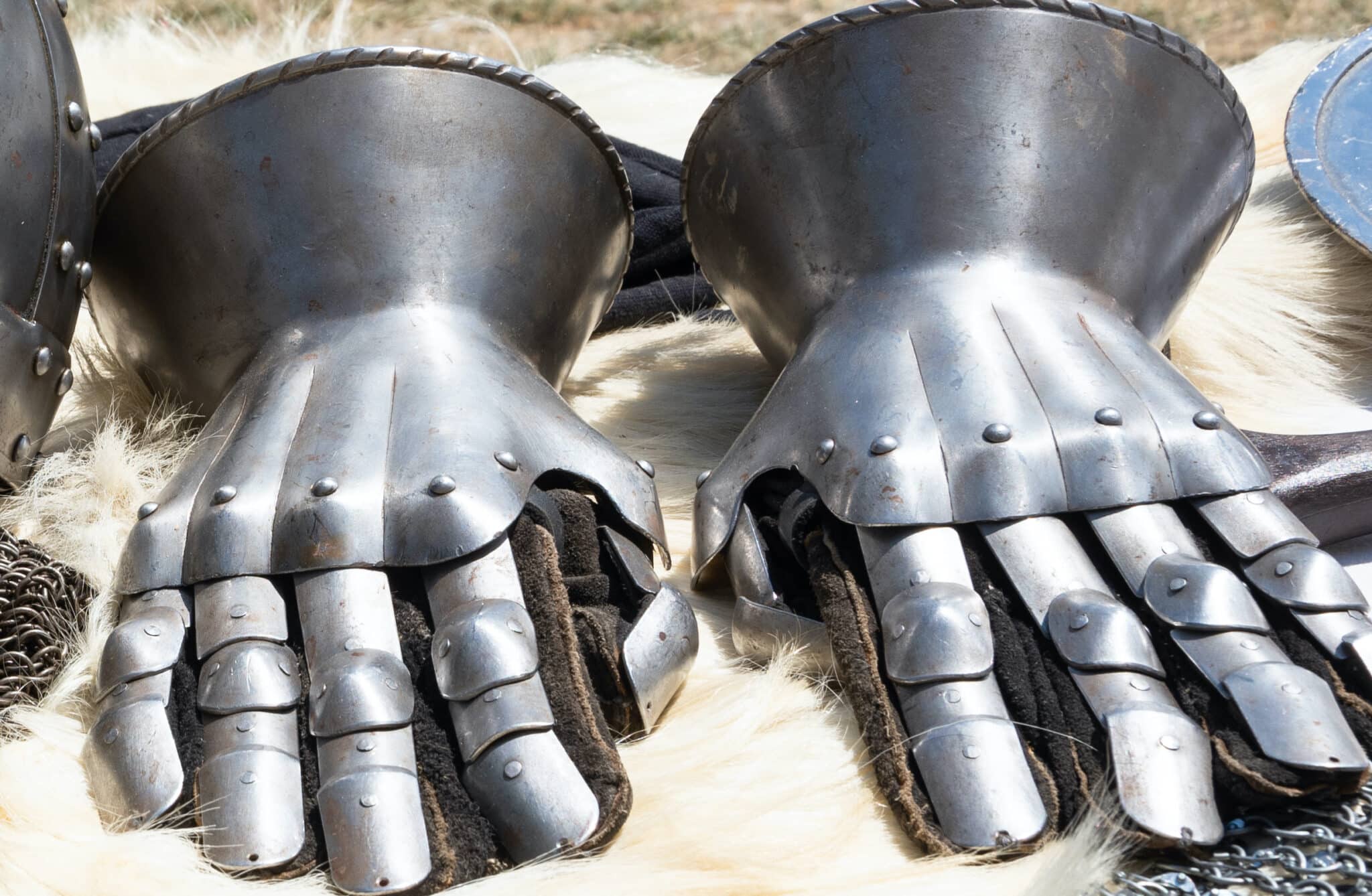 Gauntlets
Gauntlets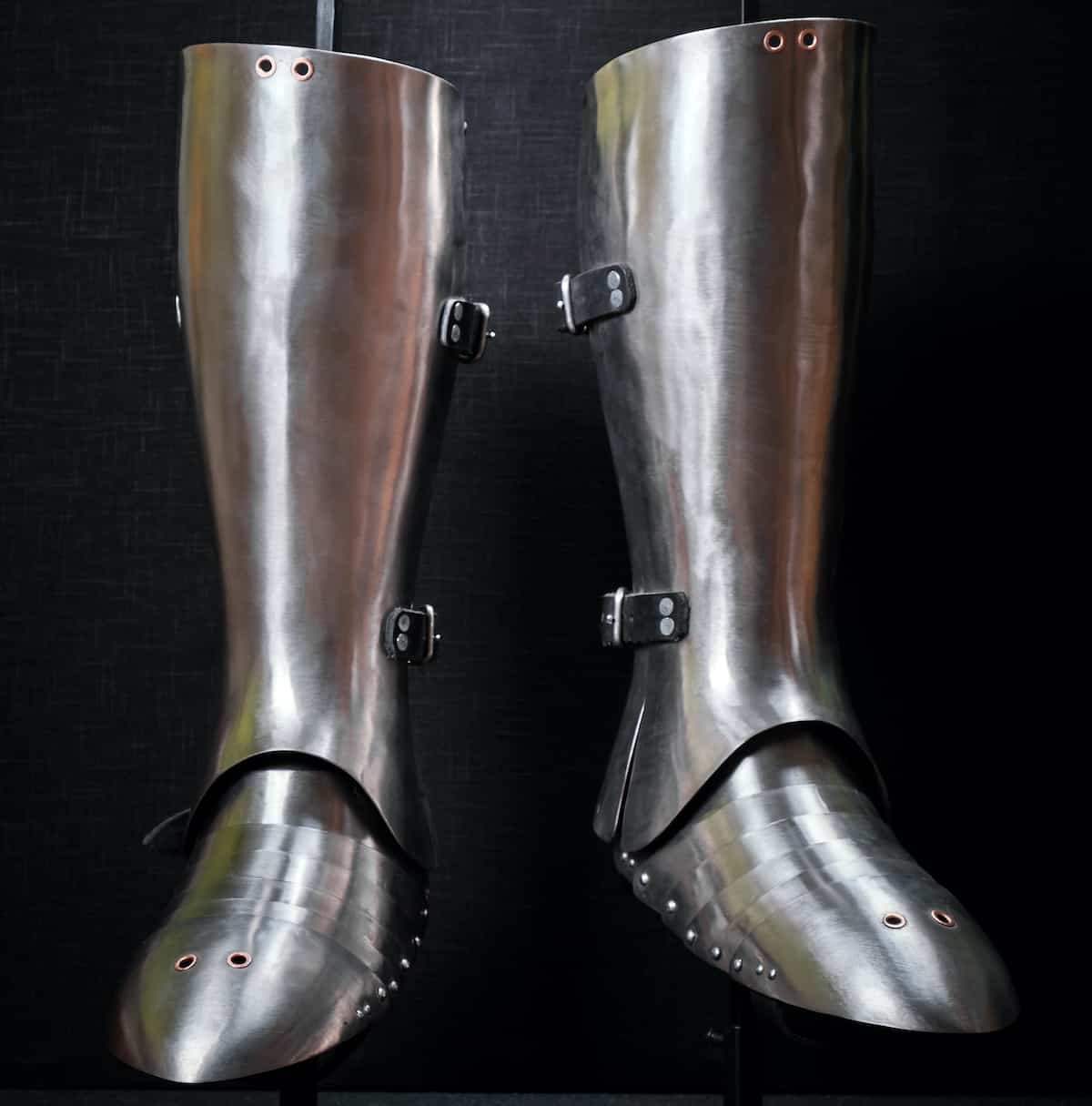 Leg Armor
Leg Armor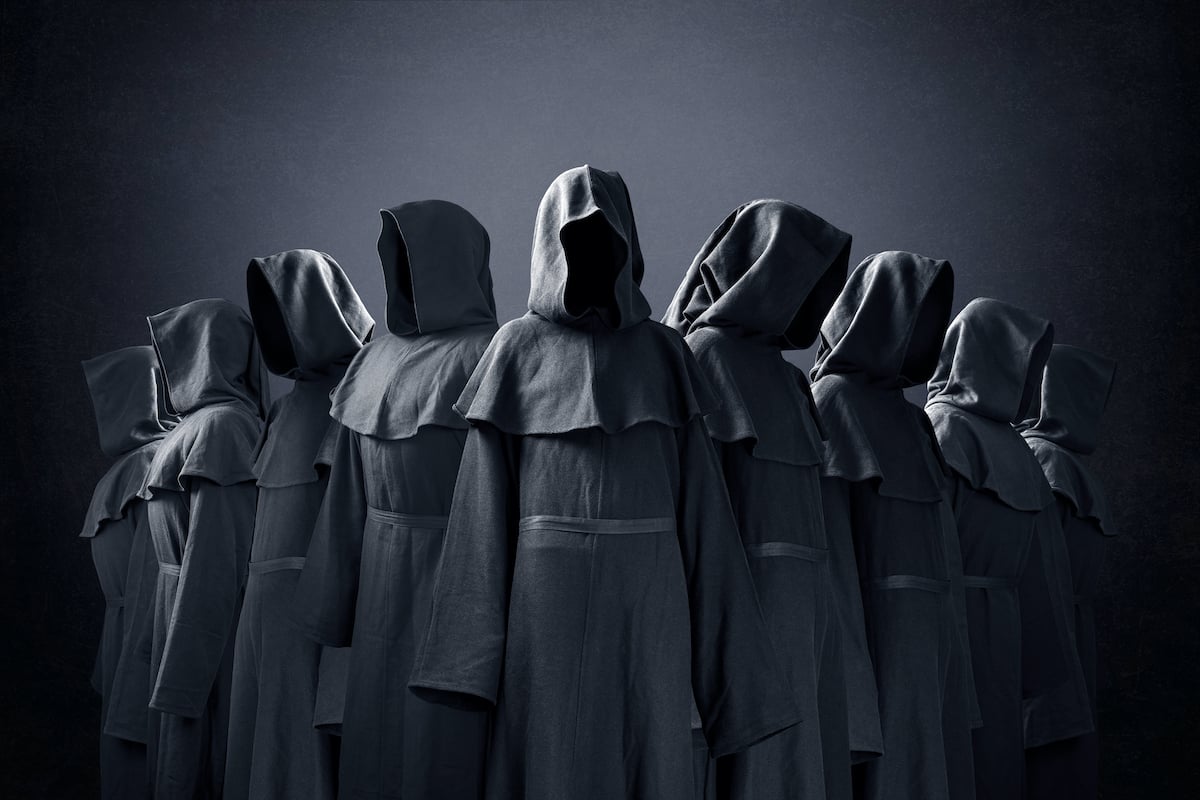 Cloaks
Cloaks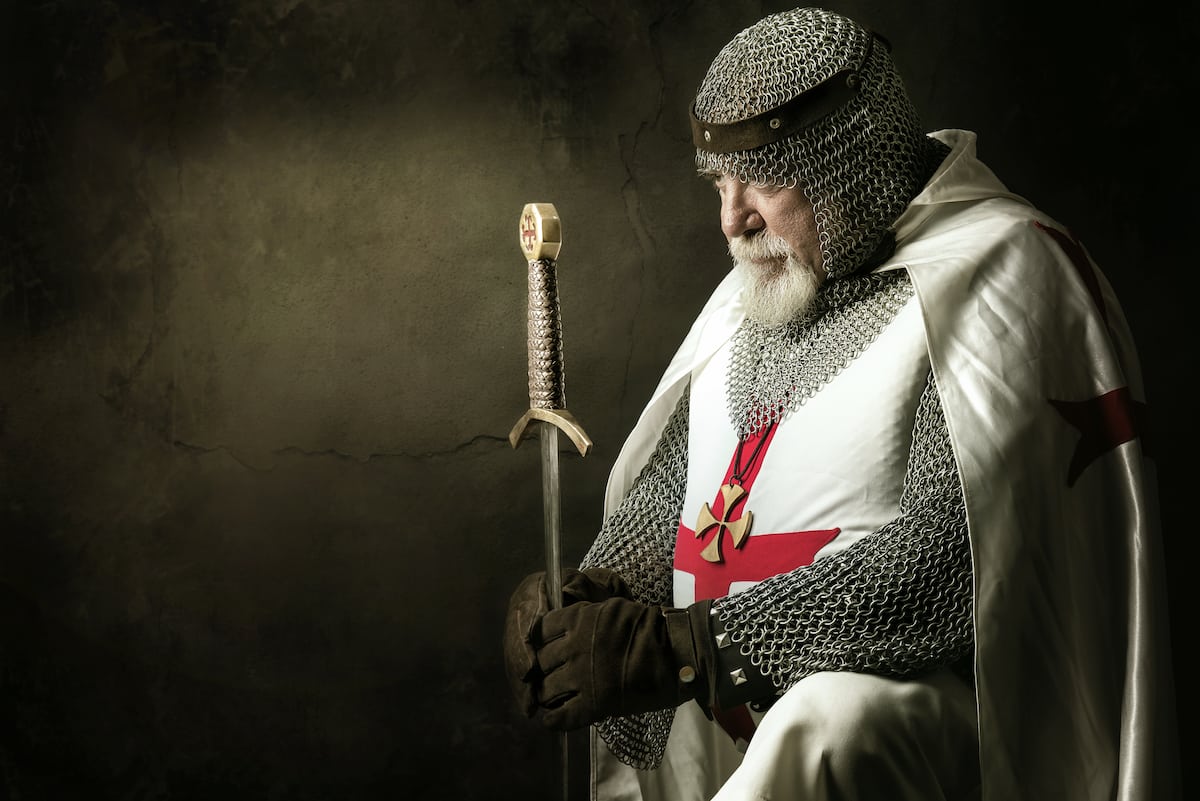 Tabards
Tabards Shirts
Shirts Tunics
Tunics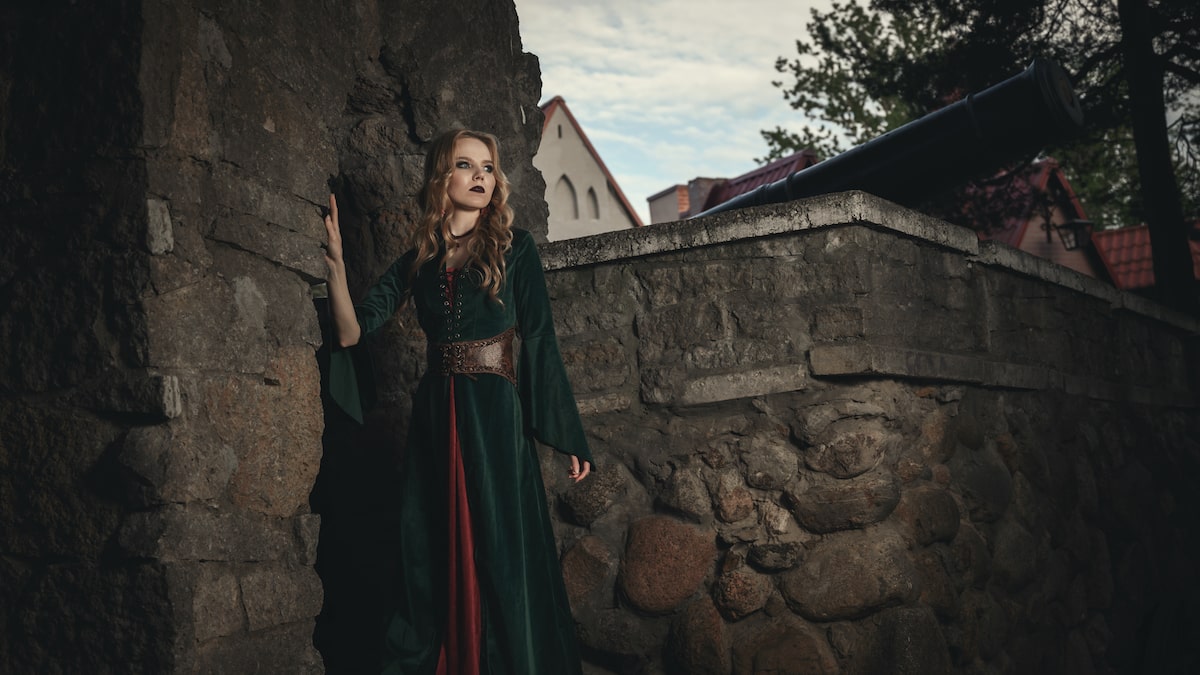 Dresses
Dresses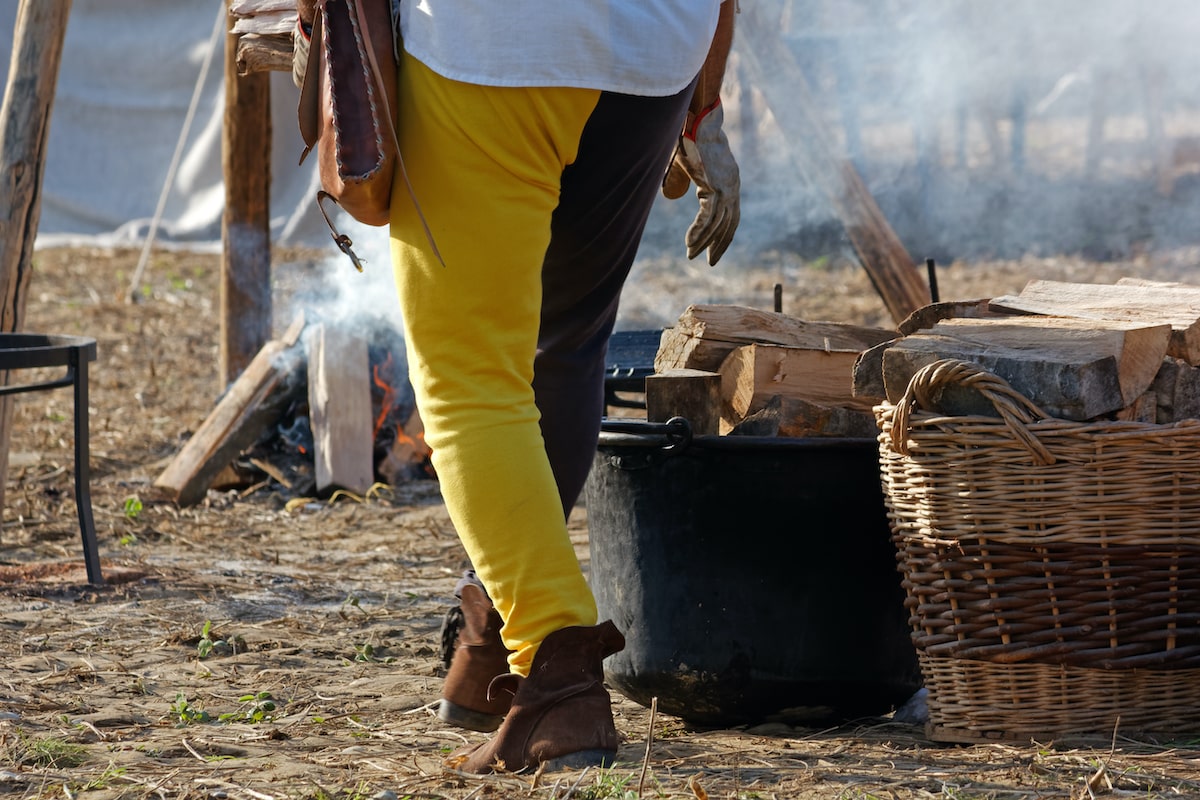 Pants
Pants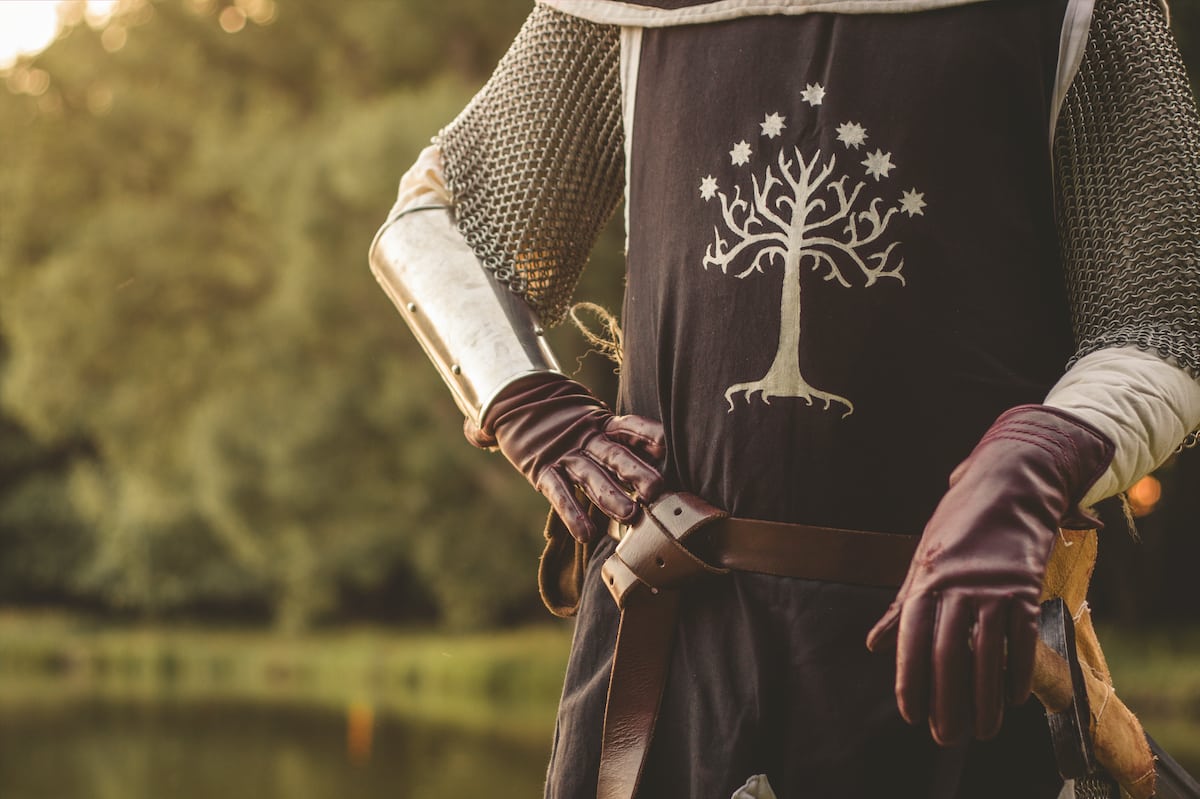 Gloves
Gloves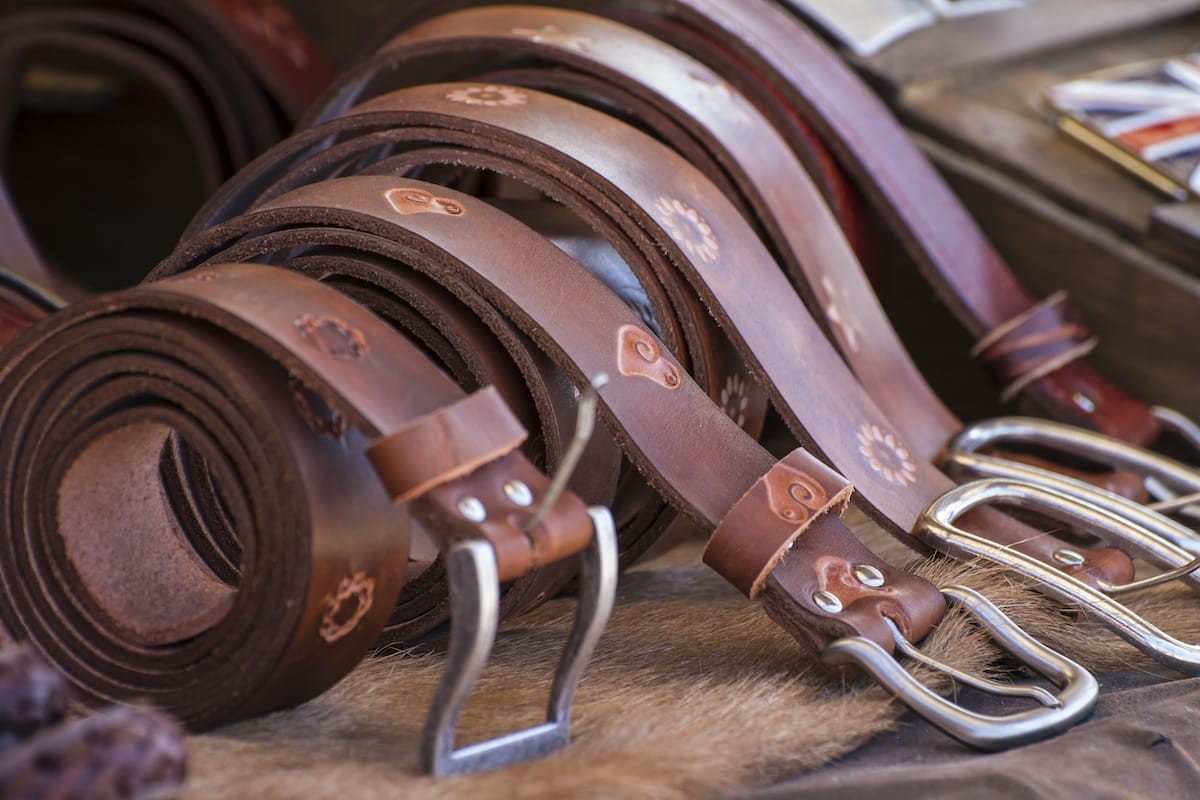 Belts
Belts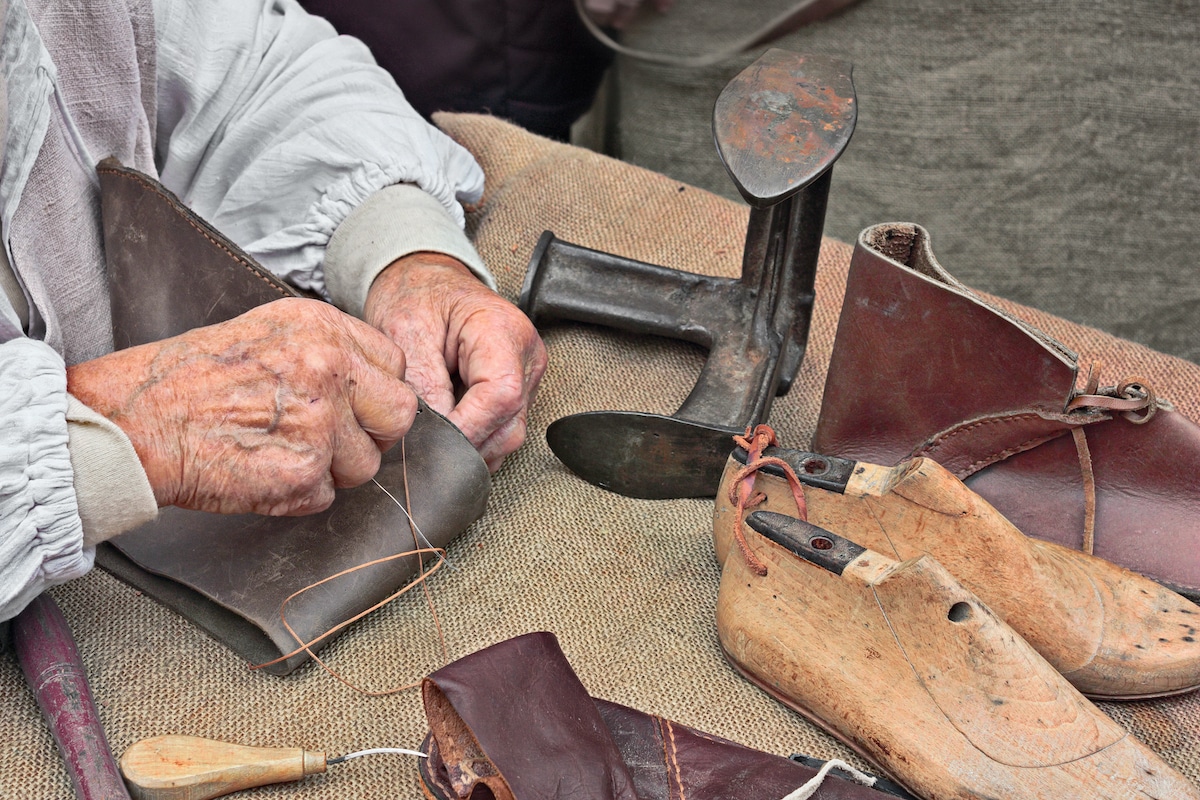 Shoes
Shoes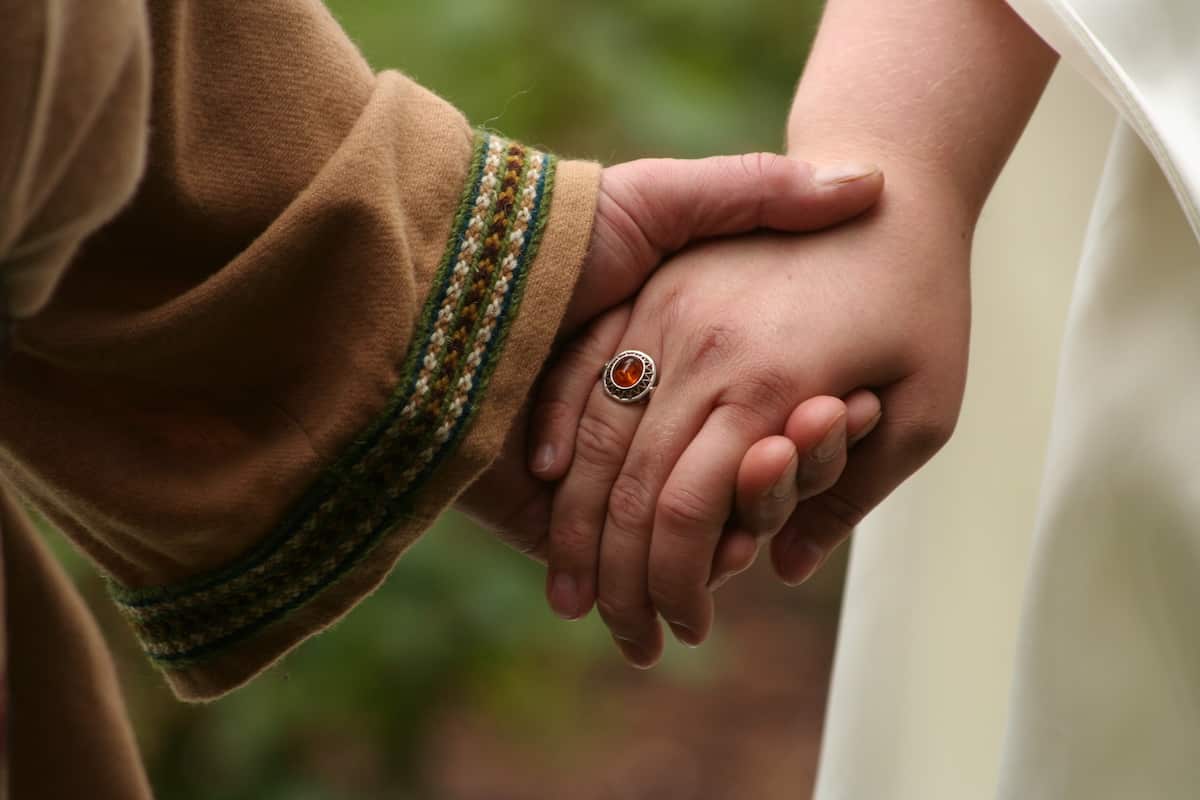 Rings
Rings Necklaces & Pendants
Necklaces & Pendants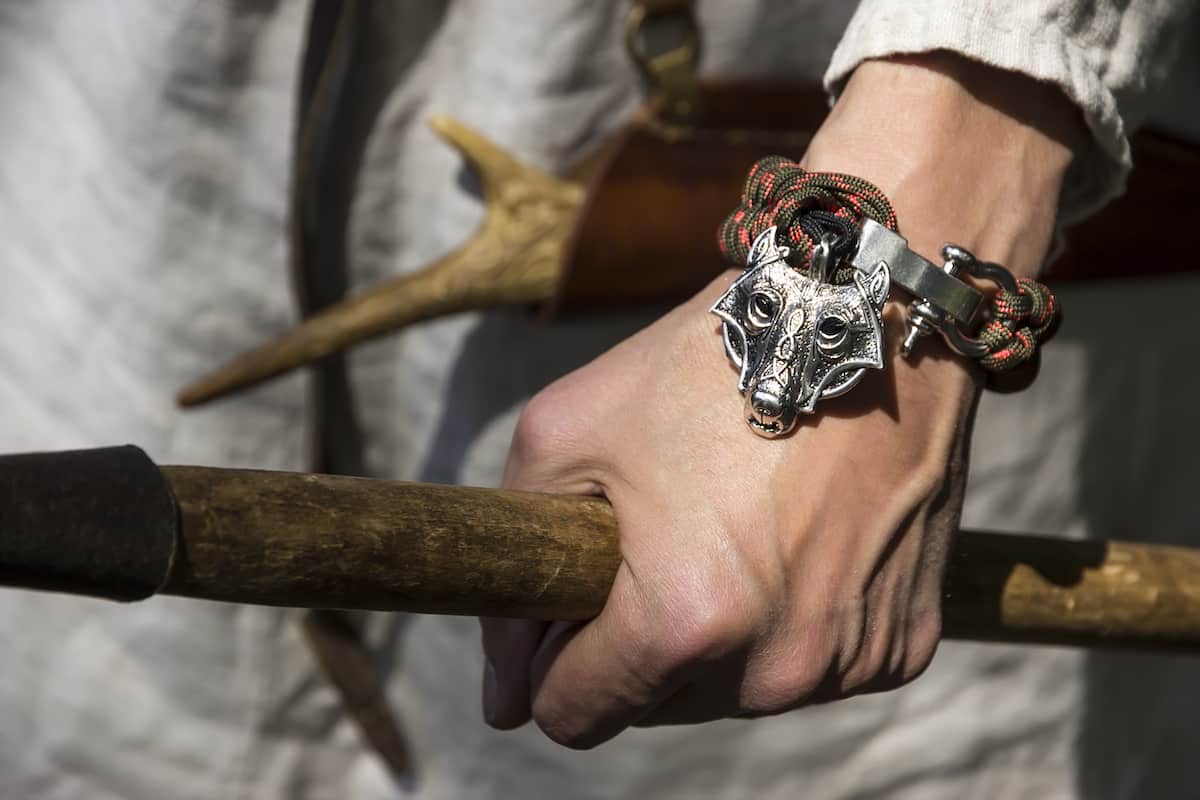 Bracelets
Bracelets